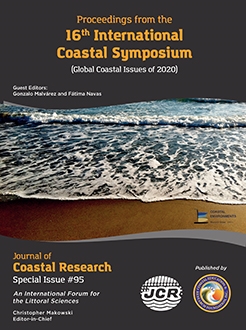Choi, T.J.; Choi, J.Y.; Park, J.Y., and Yang, Y.J., 2020. Long-term temporal and spatial morphological variability of a nourished beach using the EOF analysis. In: Malvárez, G. and Navas, F. (eds.), Global Coastal Issues of 2020. Journal of Coastal Research, Special Issue No. 95, pp. 428–432. Coconut Creek (Florida), ISSN 0749-0208.
Byeonsan Beach located at the west coast of Korea has been eroded seriously since 2006 after the construction of the Saemangeum dike. For this reason beach nourishment has been conducted from 2011 until 2017, and the result was successful by turning the beach in erosional phase of -4.1 cm/yr (2006 to 2010) into depositional condition of +2.0 cm/yr (2011 to 2017). Based on the EOF analysis of sixty-nine beach surveys during 13-year period from 2006 to 2019, the first four modes accounted for nearly 83% of total variability, leading to the interpretations of beach-nourishment effect, artificial construction, the influence of beach ridges migration, and irrigation-channel effect, respectively.





